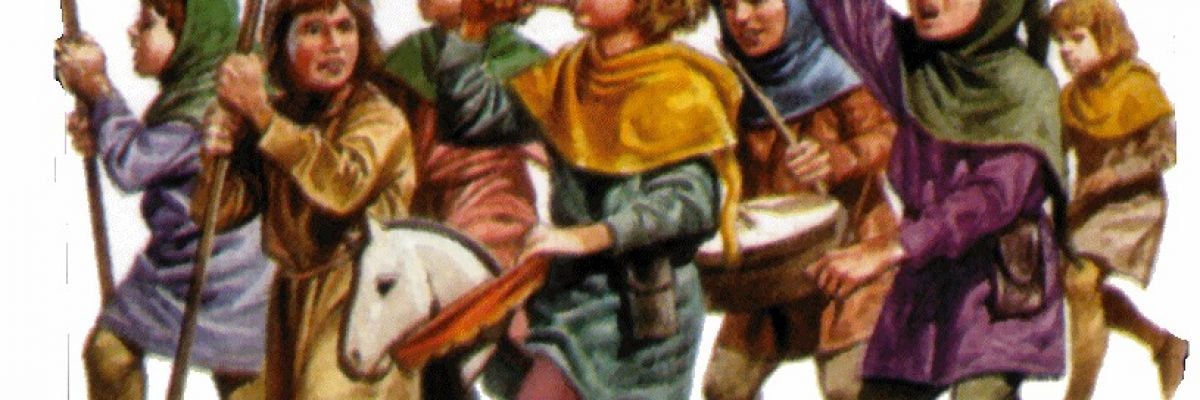
This post is the fifth in a series about the most prevalent modern myths about the Crusades and how to refute them.
Pick up most books on the Middle Ages geared toward elementary-school students and you will more than likely find an article on the so-called “Children’s Crusade,” complete with pictures of boys and girls running away from home to fight Muslims in the Holy Land. The accompanying narrative cites this episode as the perfect example of what was wrong with the medieval period and the role of the Catholic Church in that age. It was the evil and corrupt Church, the narrative goes, that encouraged innocent children to throw away their lives by participating in the Crusades for the opportunity to gain religious benefits. Since medieval people were uneducated, superstitious, and trusting of the Church, they gladly left home and families at the call of the pope. The implication is that the tragedy of the so-called “Children’s Crusade” would not have occurred absent the influence of the Catholic Church.
It is difficult for most Catholics to refute this false narrative because the very phrase “Children’s Crusade” engenders a mental picture of toddlers running wild with broadswords and crossbows and raises questions of how and why the Church could have supported such an endeavor. However, the Catholic armed with the real story of the “Children’s Crusade” is able to easily refute the modern false narrative, because actual history is certainly less salacious than modern critics contend.
The term “Children’s Crusade” is a misnomer, since the majority of participants were teenagers and young adults (not toddlers or small children), and none were actual Crusaders recognized by the Church. In essence, the “Children’s Crusade” was an urban migration of mostly poor young people who were influenced by the popular acceptance of the Crusading movement. The Church showed little interest in this youth movement, as there were neither condemnations nor public pronouncements of support. What is known about the “Children’s Crusade” has been cobbled together from various sources of contemporaries, or from those who later handed on and embellished the story. Unlike the major Crusades, there are no personal memoirs from this episode of Crusading history.
What is known for certain about the misnamed “Children’s Crusade” is that between Easter and Pentecost of 1212, young people in the Chartrain region of France near Paris, motivated by religious fervor, took the cross. The movement grew in strength and numbers when a charismatic youth from Cloyes named Stephen became its de facto leader. Stephen of Cloyes was a shepherd who believed Jesus had appeared to him and given him letters to be delivered to King Philip II Augustus in Paris.
When they arrived in the royal city, members of the group made known their desire to see Philip. But the king refused to meet them and made known through his officials his command for them to return home to their families. At this kingly imperative, the story of Stephen of Cloyes and the “Children’s Crusade” in France comes to an end. Disappointed by the king’s response, many of the French youth complied; but others ignored the command and continued their procession eastward toward the Rhineland.
The remnant of the French youth movement crossed the Rhine and gathered new members from among German youths. Unlike the French movement, which mostly contained young people, the Rhineland expedition included a wide cross-section of society, from urban workers to the elderly to mothers and infants and even entire families. What linked both the French and German movements was the complete absence of armed warriors or clergy. Echoing traditional Crusading goals, the Rhineland youths called for the liberation of the Holy Sepulchre and the return of the Holy City to Christian control.
Just as the French element of the “Children’s Crusade” grew in numbers due to the charismatic leadership of Stephen of Cloyes, so too did the Rhineland movement from the leadership of Nicholas of Cologne. There is nothing known for certain about Nicholas’s background or motivations, but it is well accepted that he was a pious man who attracted thousands of people to join him in an expedition to liberate Jerusalem.
Nicholas’s objective was to march to the sea to find transport to the Holy Land, and so he led the youths of the Rhineland across the Alps and into Italy in late July 1212. The group arrived in Piacenza and then continued on to Genoa. Once in Italy, the movement began to dissolve as initial enthusiasm waned with the weariness of travel and the recognition of reality. As a result, many of Nicholas’s followers decided to end their participation by settling in Genoa, while others continued on to Pisa. Still others, perhaps the remaining French element, left Italy for Marseilles, where they hoped to find transport to the Holy Land.
Instead, immoral merchants duped them into boarding ships bound for Alexandria, whereafter some were drowned in shipwrecks and others were sold into slavery. The remaining youth went to Rome, where they requested release from their Crusade vow from Pope Innocent III. Those younger than fourteen and the elderly were granted their request, but the rest of the participants were held to their vow. Nicholas was last sighted in the port of Brindisi looking for transport to the Holy Land. It is possible that he fulfilled his Crusade vow by joining the Fifth Crusade and fighting in the Egyptian campaign of 1218–1221.
Like the Fourth Crusade’s sack of Constantinople, the “Children’s Crusade” is one of the most often recalled episodes of Crusading history by modernity. The modern false understanding of the Crusades in general, and the “Children’s Crusade” in particular, has its origins in the writings of anti-Catholic Enlightenment thinkers. The Frenchman Voltaire (1694–1778) specifically used the “Children’s Crusade” to attack the Church by blaming the clergy for their ultimate demise: “This epidemic disease [i.e., the Crusading movement] spread even to children. Thousands of them, led by their schoolmasters and monks, left their parents’ homes on the faith of these words: ‘Lord, you have drawn your glory from children.’ Their leaders sold some of them to the Muslims; the rest died of poverty.”[1]
Despite its use by modern critics, the “Children’s Crusade” is not an example of wicked and greedy clergy, a corrupt Church, or the evil of the Crusades. Instead, this was a processional movement of deeply pious medieval young people enraptured by the Crusading fervor of their time. The movement was not sanctioned by the Church, nor supported by any major secular ruler, and that factor, more than any other, ensured its failure.
[1] Voltaire, Le Micromégas avec une historie des croisades (London, 1752), 103. Quoted in Gary Dickson, The Children’s Crusade — Medieval History, Modern Mythistory (New York: Palgrave Macmillian, 2010), 171.



